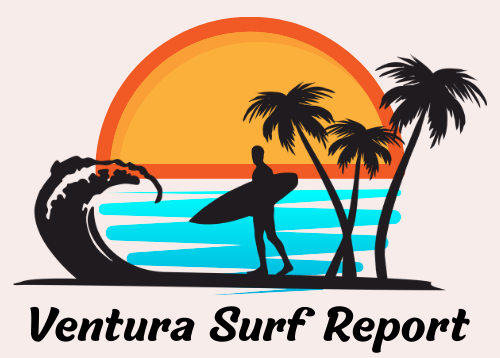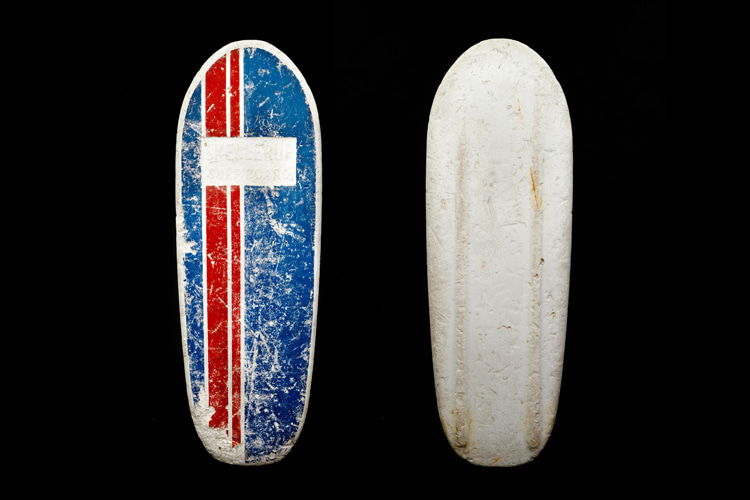
In the 1960s and 1970s, an unusual surf market phenomenon hit Australia before expanding to other parts of the world. It was the Coolite surfboard.
The shortboard revolution was a process that changed surfing forever.
It reshaped wave-riding vehicles from heavy, long boards in the nine-foot-plus range to light, highly maneuverable six-foot weapons.
It did not take place in a couple of months, but mainly between 1967 and 1970.
However, before that, one surfboard concept changed the lives of many youngsters during the summer holidays.
It was called the Coolite.
Cheap, Light, and Fun
Coolite was an inexpensive polystyrene beaded foam surfboard that introduced many people to surfing, including future world champions like Damien Hardman, Pam Burridge, and Tom Carroll.
The original Coolite was a small board. It was around 4′-5′ long, 18 to 20 inches wide, and roughly four to six inches thick.
The shapes varied a little, but most of them featured a sunken deck that resulted in one or two long, narrow fin-like runners along the bottom, and rounded noses and tails.
They were sold in Australia and basically replaced the old “surf-o-plane” surf mat invented by Ernest Smithers in 1932.
Later, similar models appeared in American and European drugstores, supermarkets, and seaside shops, selling for $10 or a bit more.
However, the first boom took place in the 1970s Downunder.
“Australian surfboard manufacturer Shane Stedman produced thousands of blunt-nosed, brightly colored coolites, while Kentucky Fried Chicken sold more than 100,000 coolites during two six-week promotions in 1973 and 1975 – each board going for $5 with the purchase of a bucket of chicken,” notes Matt Warshaw, author of “The Encyclopedia of Surfing.”
“They were allowed inside the lifeguard-patrolled ‘no surfboard’ zones, which was a relief to parents.”
Coolite: From Refrigerators to Surfboards
It was the equivalent of dodging the black ball flag in California with a bodyboard. In fact, the Coolite resembled a bodyboard before the boogie board was invented by Tom Morey in 1971.
Coolite was a type of refrigeration insulation foam plastic developed by the Hardie Rubber Company. It had a density of around two pounds per cubic foot.
However, the expression “coolite” became a generic term for the Australian surfboard.
It was cheap, fun, super light to carry, and resisted a few good wipeouts, even though many succumbed to tougher beating and broke in half.
They were raw, unglassed polystyrene on which bare skin or t-shirts would lie.
“The things bred awful cases of stomach rash from constant rubbing against the squeaky, stiff foam, until the kids realized t-shirts might not be a bad idea,” Nick Carroll wrote in 2001.

Portable Marketing Tools
Many surf companies and mainstream brands produced their own shapes and used Coolites to boost their sales and promote their non-surf-related businesses.
Models like the Midget Farrelly Pro Champ, Skellerup, Shane Aquarius Mark 2, Scard, Hanimex, Firestone, and others were very popular.
But in terms of oddness, nothing beats the coolite by Kentucky Fried Chicken (KFC) featuring the good old Colonel Sanders red logo floating in the nose of the board.
Soon, all these puffy foamies would grow in size to compete with the long and shortboards used by intermediate and advanced surfers.
Some manufacturers also embedded a molded rubber fin to improve the stability in the waves.
There were also surfboard shapers and DIY enthusiasts trying to modify original coolite boards by adding, for instance, spray paint, or their own custom-made fiberglass or plywood fins.
Glassing was not a good idea, though.
“The styrene foam reacted badly to polyester surfboard resin and would dissolve into a horrid white paste,” explained Carroll.
“Only years later would US East Coast designer Greg Loehr figure out a system of laminating Coolite-style foam with styrene-friendly epoxy resins.”
An All-Around Wave-Riding Vehicle
But the fact that these lightweight wave-riding vehicles beat many surf zone restrictions was amazing. And they also came with a few extra bonuses.
“My brother and I lived in Perth, right near the City, so we had to take our coolites to City Beach on the bus,” reveals Mal Leckie in the book and website “Surfing Down South.”
“We had plywood single fins glued in. At first, it was free, but then MTT [Metropolitan Transport Trust] decided that surfboards had to pay a second fare, and their definition of a surfboard was whether it had a fin or not.”
“So we made T-shaped plywood fins that went right through from the deck, and we could take them out and hide them in our bags for the bus trip to save the extra fare.”
“That worked OK unless you were lying down on the board and hit the sand – some lower pain resulted. About that time, we discovered the split pin.”
The Coolite was even used as a small sailing craft using homemade masts, sails, and skegs.
And there is also the story of bodysurfer and surfer Ron “Pixie” Moss from the City of Perth Surf Life Saving Club who rode a Coolite to victory in a surfboard competition held in the late 1970s at Trigg Beach.

Where Are They?
With the success and materials proposed by Morey Boogie and the bodyboard, Coolite’s success eventually faded. But it wasn’t forgotten.
Today, there are still many Coolite boards alive and well, covered in dust, and hidden in the attics and garages of the world. The Australian National Surfing Museum has a few in its collection, too.
They may have been the poor parents of surfboards in the 1970s and 1980s, but they sure were a safe and fun introduction to surfing for hundreds of thousands of teenagers worldwide.
Have you got pictures of your Coolite-style boards? Send us an email and share them with the readers.
Words by Luís MP | Founder of SurferToday.com


Leave a Reply